|
|
 |
|
Calanoida ( Order ) |
|
|
|
Arietelloidea ( Superfamily ) |
|
|
|
Augaptilidae ( Family ) |
|
|
|
Augaptilus ( Genus ) |
|
|
| |
Augaptilus glacialis Sars, 1900 (F,M) | |
| | | | | | | Syn.: | Augaptilus zetesios Wolfenden, 1902 (p.369, figs.F); Fowler, 1903 a (p.125); Wolfenden, 1904 (p.122); van Breemen, 1908 a (p.136); Chahsavar-Archad & Razouls, 1982 (p.28, 38, figs.F) | | | | Ref.: | | | Sars, 1900 (p.88, figs.F,M); 1925 (p.254, figs.F,M); Rose, 1933 a (p.216, figs.F,M); Jespersen, 1934 (p.111); 1940 (p.57); Brodsky, 1950 (1967) (p.368, figs.F,M); Vervoort, 1951 (p.144, figs.M, Rem.); 1957 (p.138, Rem.); Tanaka, 1964 b (p.77, figs.F,M); Vervoort, 1965 (p.130, Rem.); Vidal, 1971 a (p.12, 21, 112, figs.F, M); Minoda, 1971 (p.41); Tanaka & Omori, 1971 (p.259, fig.F); Matthews, 1972 (p.46, 59: Rem.); Mazzocchi & al., 1995 (p.25, figs.F,M, Rem.); Chihara & Murano, 1997 (p.720, Pl.: 57: F); Bradford-Grieve & al., 1999 (p.882, 939, figs.F,M); Boxshall & Halsey, 2004 (p.67: fig.M); Vives & Shmeleva, 2007 (p.173, figs.F,M, Rem.) |  issued from : O. Tanaka in Publs Seto Mar. Biol. Lab., 1964, XII (1). [p.78, Fig.212]. Female: a, habitus (dorsal); b, forehead (left lateral side); c, last thoracic segment and urosome); d, A2; e, Md (biting blade and mandibular palp, separately); f, P1; g, P5. Nota: The urosome segments and furca are in the proportional lengths as 32:10:20:38 = 100. The rostral filaments short. A1 exceeds the end of the furca by distal 5 segments. Male: h, forehead (right lateral side); i, P5. Nota: The urosome segments and furca are in the proportional lengths as 16:14:12:11:10:37 = 100. Right A1 exceeds the end of the furca by terminal 1 or 2 segments. Grasping of A1 on the left side.
|
 Issued from: M.G. Mazzocchi, G. Zagami, A. Ianora, L. Guglielmo & J. Hure in Atlas of Marine Zooplankton Straits of Magellan. Copepods. L. Guglielmo & A. Ianora (Eds.), 1995. [p.27, Fig.3.1.1]. Female: habitus (dorsal); B, P5; C, Md (cutting edge of mandibular blade). Nota: A1 exceeds end of furca by distal 4-5 segments. Proportional lengths of urosomites and furca 39:11:17:33 = 100. Caudal rami 5 times longer than wide and strongly divergent. Anal somite and furca naked on dorsal side, coarsely covered with fine hairs on ventral surface. Male: D, habitus (dorsal); E, P5. Nota: Left A1 geniculated. Proportional lengths of urosomites and furca 16:13:13:11:14:33 = 100. Ventral side of caudal rami bearing long hairs. P5 slightly asymmetrical.
|
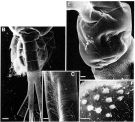 Issued from: M.G. Mazzocchi, G. Zagami, A. Ianora, L. Guglielmo & J. Hure in Atlas of Marine Zooplankton Straits of Magellan. Copepods. L. Guglielmo & A. Ianora (Eds.), 1995. [p.29, Fig.3.1.3]. Male (SEM preparation): B, urosome (dorsal); C, ventral surface of furca; E, basipod 2 of right P5; F, detail of blunt denticles on basipodal segment 2 of right P5 (arrowed in E). Bars: B 0.100 mm; C, E 0.010 mm; F, 0.005 mm.
|
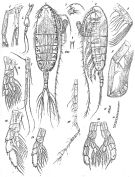 Issued from : G.O. Sars in Résult. Camp. Scient. Prince Albert I, 69, pls.1-127 (1924). [Pl.LXXVI, figs.1-16]. Female: 1, habitus (dorsal); 2, idem (lateral left side); 3, forehead (lateral); 4, rostrum; 5, A2; 6, Md; 7, Mx1; 8, Mx2; 9, Mxp; 10, distal part of seta of Mxp (enlarged); 11, lateral surtellum-like buds on the same seta (enlarged); 12, P1; 13, P2; 14, P5. Male: 15, left A1; 16, P5.
|
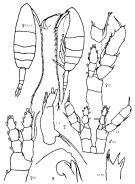 Issued from : K.A. Brodskii in Calanoida of the Far Eastern Seas and Polar Basin of the USSR. Opred. Fauna SSSR, 1950, 35 (Israel Program for Scientific Translations, Jerusalem, 1967) [p.369, Fig.258]. Female (from central part Arctic): habitus (dorsal and lateral left side); forehead (lateral); MRi, right Md (biting edge); Mx, Mx1; S1, P1; S5, P5. Male: S5, P5 (Le = left leg).
|
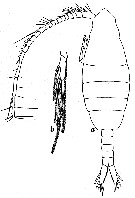 issued from : W. Vervoort in Verh. K. ned. Akad. Wet., Afd. Natuurk., 1951, (Sect. 2) 47 (2). [p.145, Fig.80]. Male (from ±66°.5S, 11°W): a, habitus (dorsal); b, left caudal ramus (dorsal).
|
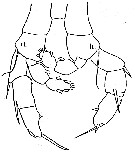 issued from : W. Vervoort in Verh. K. ned. Akad. Wet., Afd. Natuurk., 1951, (Sect. 2) 47 (2). [p.146, Fig.81). Male: P5 anterior; rt = right foot, lt = left foot). Nota: The Sars'drawings of P5 differ slightly in the length of the marginal spines of both exopods.
|
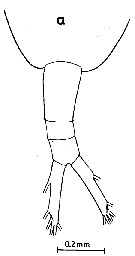 issued from : O. Tanaka & M. Omori in Publ. Seto Mar. Biol. Lab., 1971, XIX, 4. [p.260, Fig.5, a]. Female (from Izu Region): a, last thoracic segment and urosome (dorsal).
|
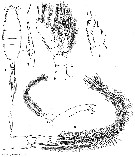 issued from : R.N. Wolfenden in J. mar biol. Ass. U.K., 1902, n.ser. 6 (1). [Pl. III, 1-3, 6-8]. As Augaptilus zetesios. Female (from Faröe Channel): 1, habitus (dorsal); 2, P5; 3, spine on 2nd segment of exopodite of P5; 6, exopodal segment 3 of P1; 7, Md; 8, Mx1.
|
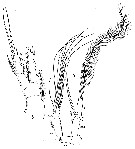 issued from : R.N. Wolfenden in J. mar biol. Ass. U.K., 1902, n. ser. 6 (1). [Pl. III, 5, 9]. As Augaptilus zetesios. Female: 5, P1; 9, A2.
|
 issued from : R.N. Wolfenden in J. mar. biol. Ass. U.K., 1902, n. ser. 6 (1). [Pl. III, 10]. As Augaptilus zetesios. Female: 10, Mx2.
|
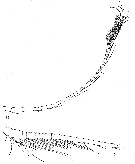 issued from : R.N. Wolfenden in J. mar. biol. Ass. U.K., 1902, n. ser. 6 (1). [Pl. III, 13]. As Augaptilus zetesios. Female: 12, A1.
|
 issued from : R.N. Wolfenden in J. mar. biol. Ass. U.K., 1902, n. ser. 6 (1). [Pl. III, 11, 12]. As Augaptilus zetesios. Female: 11, Mxp; 12, processes on bristles of Mxp.
|
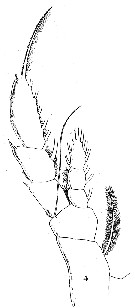 issued from : R.N. Wolfenden in J. mar. biol. Ass. U.K., 1902, n. ser. 6 (1). [Pl. III, 4]. As Augaptilus zetesios. Female: 4, P4.
| | | | | Compl. Ref.: | | | Mrazek, 1902 (p.523); Damas & Koefoed, 1907 (p.400, tab.II); Rose, 1937 a (p.12); Sewell, 1948 (p.496, 504); C.B. Wilson, 1950 (p.170); Østvedt, 1955 (p.15: Table 3, p.76); M.W. Johnson, 1963 (p.89, Table 1, 2); Unterüberbacher, 1964 (p.30); De Decker & Mombeck, 1964 (p.11); Grice & Hulsemann, 1965 (p.224); Mazza, 1966 (p.72); 1967 (p.344); Grice & Hulsemann, 1967 (p.18); Harding, 1966 (p.17, 71); Vinogradov, 1968 (1970) (p.261); Itoh, 1970 (tab.1); Roe, 1972 (p.277, tabl.1, tabl.2); Björnberg, 1973 (p.348, 384); Deevey & Brooks, 1977 (p.156, tab.2, Station "S"); Buchanan & Sekerak, 1982 (p.41, vertical distribution); Vives, 1982 (p.294); Kovalev & Shmeleva, 1982 (p.85); Roe, 1984 (p.358); Groendahl & Hernroth, 1986 (tab.1); Lozano Soldevilla & al., 1988 (p.59); Hopkins & Torres, 1988 (tab.1); Kosobokova, 1989 (p.27); Heinrich, 1990 (p.18); Mumm, 1993 (tab.1, fig.2); Richter, 1994 (tab.4.1a); Shih & Young,1995 (p.67); Hanssen, 1997 (tab.3.1); Kosobokova & al., 1998 (tab.2); Voronina & Kolosova, 1999 (p.71, comme glacilis); Lapernat, 2000 (tabl. 3, 4); Razouls & al., 2000 (p.343, tab. 5, Appendix); Kosobokova & Hirche, 2000 (p.2029, tab.2); Auel & Hagen, 2002 (p.1013, tab.2); ? Lo & al., 2004 (p.89, tab.1 as gracilis :? lapsus calami); Hop & al., p.182, Table 4); Schnack-Schiel & al., 2008 (p.1045: Tab.2); Kosobokova & al., 2007 (p.919, Tab.3, 6, fig.2); Blachowiak-Samolyk & al., 2007 (p.2716, Table 2); Galbraith, 2009 (pers. comm.); Park & Ferrari, 2009 (p.143, Table 4, Appendix 1, biogeography); Kosobokova & Hopcroft, 2010 (p.96, Table 1, fig.7); Dvoretsky & Dvoretsky, 2010 (p.991, Table 2); Bucklin & al., 2010 (p.40, Table 1, Biol mol.); Kosobokova & al, 2011 (p.29, Table 2, fig.4, Rem.: Arctic Basins); Hidalgo & al., 2012 (p.134, Table 2); Belmonte, 2018 (p.273, Table I: Italian zones); Hure M. & al., 2018 (p.1, 5, 10: Rem.) | | | | NZ: | 19 | | |
|
Distribution map of Augaptilus glacialis by geographical zones
|
| | | | | | | | | | | | | | | | | |  issued from : W. Vervoort in B.A.N.Z. Antarctic Reseach Expedition, Reports - Ser. B, Vol. III, 1957 [Fig.131] issued from : W. Vervoort in B.A.N.Z. Antarctic Reseach Expedition, Reports - Ser. B, Vol. III, 1957 [Fig.131]
Chart showing the geographical distribution (white circle) in the seas surrounding the Antarctic continent.
Nota: In this chart the area frequented by whaling vessels has been hatched. The Antarctic circle (66°.5 S) has been drawn as a broken line. The numbers I to VI refer to the sectors into which the Antarctic seas are divided according to Mackintosh (1942) (after Vervoort, 1951). |
| | | | Loc: | | | Antarct. (Weddell Sea, SE Atlant., Indian), sub-Antarct. (Indian, SE Pacif.), Straits of Magellan (Pacific area), South Africa (E), Atlant. (tropical, temperate), Namibia, G. of Guinea, off NW Cape Verde Is., off S Cape Verde Is., off Madeira, Portugal, off W Cabo Finisterre, Azores, W Gibraltar, Medit. (Algiers, Ligurian Sea, Tyrrhenian Sea, off Dubrovnik ), off Amazon, off Bermuda (Station "S"), Sargasso Sea, Arct. (all polar basins), Arct. (Fram Strait, central, Fletcher's Ice Is.), Canadian abyssal plain, Canada Basin, Baffin Bay, Fram Strait, Greenland Sea, Barents Sea, Nansen Basin, Laptev Sea, S Iceland, Faroe Is., Norway Sea, North Sea, Indian, China Seas (East China Sea, South China Sea), ? Taiwan (N: Mienhua Canyon), Japan, Pacif. (NW & NE), Hawaii-California, Vancouver Is., Pacif. (SE tropical), Chile, off Santiago. | | | | N: | 63 | | | | Lg.: | | | (1) F: 5,3; (16) F: 4,9-4,1; M: 3,8-3,7; (22) F: 5,3-4,6; M: 5,1-4,4; (25) F: 5,72; (31) M: 4,43; (36) F: 5,19-4,51; M: 4,39-4,04; (69) F: 5,88; M: 5,19; (90) F: 5,9-4,03; (134) F: 4,82; (199) F: 4,96-4,32; M: 3,52; (208) F: 5,1; M: 5; (432) F: 5,7-4,5; (1001) F: 4,25-4,95; {F: 4,03-5,90; M: 3,70-5,19}
The mean female size is 4.949 mm (n = 19; SD = 0.5889), and the mean male size is 4.357 mm (n = 10; SD = 0.5973). The size ratio (male : female) is 0.88 (n = 6; SD = 0.0817). | | | | Rem.: | Meso-bathypelagic. Known to extend from below 1000 to the uppermost 130 m (in the Arctic); raken once in the uppermost 200 m in the tropical Atlantic (Matthews, 1972).
Sampling depth (Antarct., sub-Antarct.) : 500-1000 m. Sargasso Sea: 500-2000 m (Deevey & Brooks, 1977, Station "S");
For Vervoort (1965, p.130) finds increasingly difficult to separate thsi species from A. longicaudatus in the material of the Atlantide Expedition; the females brought to the latter are slightly smaller and the females have the caudal rami covered with distinct though short spiniforom hairs. The females of A. glacialis generally are bigger, but the smaller females have about the same size as the large females of A. longicaudatus. In the female A. glacialis the caudal rami may be completely nude, but usually there are fine hairs along the inner border. None of the female specimens in the Atlantide Expedition has the inner margial spine of the 2nd exopodal segment of P5 as figured by Brodsky (1950, fig.258); this spine in the Atlantide specimens may be slightly denticulated externally, but never as coarse as appears from Brods's figure.
For Mazzocchi & al. (1995, p25) it seems to be difficult to separate A. glacialis from A. longicaudatus. In longicaudatus females, the caudal rami and anal somite are covered by spiniform hairs; in glacialis the caudal may be completely naked, but usually there are fine hairs along the internal borders. The caudal rami and anal somite of females are coarsely coverd with fine hairs on the ventral side (no spiniform hairs as in longicaudatus) and the genital somite without the remarkable swelling on the left side (in dorsal view) characterizing longicaudatus females. In the specimens from the Straits of Magellan (as in Vervoort, 1965), the female does not have the blunt, coarsely serrulated internal marginal spine of the exopod 2 of P5 as figurated by Brodsky (1950, fig.258) but this spine has short hairs along its length. This spine reaches the base of the 3rd inner marginal seta of the exopod 3 (in longicaudatus it reaches the 2nd marginal seta as reported by Tanaka, 1964).
Apparently, only the males of glacialis and longicaudatus can easily be separated by the P5 (only in longicaudatus does the left exopod end with a very long apical spine).
For Itoh (1970 a, fig.2, from co-ordonates) the Itoh's index value from mandibular gnathobase = 1700.
M. Hure & al; (2018, p.5, 10) record for the first time this species in the Adriatic Sea, but does not appeared in the tables 1 and 2, probably very rare/or not abundant. | | | Last update : 14/06/2022 | |
|
|
 Any use of this site for a publication will be mentioned with the following reference : Any use of this site for a publication will be mentioned with the following reference :
Razouls C., Desreumaux N., Kouwenberg J. and de Bovée F., 2005-2024. - Biodiversity of Marine Planktonic Copepods (morphology, geographical distribution and biological data). Sorbonne University, CNRS. Available at http://copepodes.obs-banyuls.fr/en [Accessed April 19, 2024] © copyright 2005-2024 Sorbonne University, CNRS
|
|
 |
 |


















